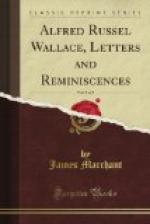The subject is so large and complex that it is not to be wondered so many people still maintain the insufficiency of Natural Selection, without having really mastered the facts. I could not, therefore, answer your question without going into some detail and giving references.... —Believe me yours very truly,
ALFRED R. WALLACE.
* * * * *
TO MR. H.N. RIDLEY
Parkstone, Dorset. October 3, 1898.
My dear Mr. Ridley,— ... We are much interested now about De Rougemont, and I dare say you have seen his story in the Wide World Magazine, while in the Daily Chronicle there have been letters, interviews and discussions without end. A few people, who think they know everything, treat him as an impostor; but unfortunately they themselves contradict each other, and so far are proved to be wrong more often than De Rougemont. I firmly believe that his story is substantially true—making allowance for his being a foreigner who learnt one system of measures, then lived thirty years among savages, and afterwards had to reproduce all his knowledge in English and Australian idioms. As an intelligent writer in the Saturday Review says, putting aside the sensational illustrations there is absolutely nothing in his story but what is quite possible and even probable. He must have reached Singapore the year after I returned home, and I dare say there are people there who remember Jensen, the owner of the schooner Veilland, with whom he sailed on his disastrous pearl-fishing expedition. Jensen is said now to be in British New Guinea, and has often spoken of his lost cargo of pearls. —— and ——, of the Royal Geographical Society, state that they are convinced of the substantial truth of the main outlines of his story, and after three interviews and innumerable questions are satisfied of his bona fides—and so am I.—With best wishes, believe me to be yours very truly,
ALFRED R. WALLACE.
* * * * *
MR. SAMUEL WADDINGTON TO A.R. WALLACE
7 Whitehall Gardens, London, S.W. February 19, 1901.
Dear Sir,—I trust you will forgive a stranger troubling you with a letter, but a friend has asked me whether, as a matter of fact, Darwin held that all living creatures descended from one and the same ancestor, and that the pedigree of a humming-bird and that of a hippopotamus would meet if traced far enough back. Can you tell me whether Darwin did teach this?
I should have thought that as life was developed once, it probably could and would be developed many times in different places, as month after month, and year after year went by; and that, from the very first, it probably took many different forms and characters, in the same way as crystals take different forms and shapes, even when composed of the same substance. From these many developments of “life” would descend as many separate lines of evolution, one ending in the humming-bird, another in the hippopotamus, a third in the kangaroo, etc., and their pedigrees (however far back they might be traced) would not join until they reached some primitive form of protoplasm,—Yours faithfully,




